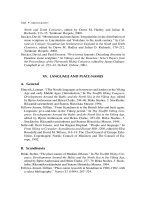What to expect on the gmat 8 pps
Bạn đang xem bản rút gọn của tài liệu. Xem và tải ngay bản đầy đủ của tài liệu tại đây (78.89 KB, 6 trang )
123
Sam bought a suit to wear to his new job, which will begin on Monday.
Emily married Sonny, who has been in love with her since first grade.
Antoinette, who is a computer programmer, would be a good match for Daniel.
Rule #10: Use who for people, that for things, and which for nonessential clauses that do not refer to
people.
Pronoun-Antecedent Agreement
Just as subjects (both nouns and pronouns) must agree with their verbs, pronouns must also agree with their
antecedents
—
the words they replace. For example, consider the following sentence:
Children will often believe everything their parents tell them.
The word children is the antecedent and is replaced by their and them in the sentence. Because children
is plural, the pronouns must also be plural.
Indefinite pronouns can also be antecedents. Singular indefinite pronouns require singular pronouns:
E
veryone has his or her own reasons for coming.
N
either of the physicists could explain what she saw.
Plural indefinite pronouns, on the other hand, require plural pronouns, just like they require plural
verbs:
both few many several
B
oth of them have finished their work.
Only a f
ew are still in their original cases.
Contraction Confusion
It is easy to make a mistake with pronouns and contractions because apostrophes are used to show posses-
sion of nouns (Ralph’s car). With pronouns, however, possession does not require an apostrophe. If you get con-
fused, think of a possessive pronoun that doesn’t get confused with contractions, such as my or our. These
do not have apostrophes; other possessive pronouns should not either.
Here is one way to remember to use that when referring to things: both words begin with the letters th.
A Bad Habit
One of the most common mistakes people make when speaking and writing is an error of pronoun-antecedent
agreement. You may often say sentences such as the following:
Everyone will receive their scores within two weeks.
Most people make this mistake because it’s easier (shorter and faster) to say their—but it’s not correct. When
the antecedent is singular, the pronouns must be singular, too:
Everyone will receive his or her scores within two weeks.
The students will receive their scores within two weeks.
124
Finally, those pronouns that can be either singular or plural, depending upon the noun or pronoun to
which they refer, should take the pronoun that matches their referent. If the antecedent is singular, the pro-
noun and verb must also be singular. If the antecedent is plural, they must be plural:
all any most none some
All of the chocolate is gone. It was delicious!
All of the cookies are gone. They were delicious!
None of the information is accurate; it’s all out of date.
None of the facts are accurate; they are all out of date.
Rule #11: Make sure pronouns agree in number and person with their antecedents.
Pronoun Consistency
Just as you need to be consistent in verb tense, you should also be consistent in your pronoun point of view.
A passage that begins in the third-person plural should continue to use that third-person plural point of view.
Incorrect: We have tested our hypothesis and the team believes it is correct.
Correct: We have tested our hypothesis and we believe it is correct.
Incorrect: If you prepare carefully, one can expect to pass the exam.
Correct: If you prepare carefully, you can expect to pass the exam.
If one prepares carefully, one can expect to pass the exam.
Rule #12: Be consistent in pronoun point of view.
Adjectives and Adverbs
Adjectives and adverbs help give our sentences color; they describe things and actions. Adjectives describe
nouns and pronouns and tell us which one, what kind, and how many:
that book romance novel several chapters
the other class steep expense multiple options
Adverbs, on the other hand, describe verbs, adjectives, and other adverbs. They tell us where, when, how,
and to what extent:
flying south arrive early sings beautifully very talented
wait here meet tomorrow fight courageously severely compromised
Remember to keep modifiers as close as possible to what they modify.
FEWER/LESS, NUMBER/AMOUNT
As a rule, use the adjective fewer to modify plural nouns or things that can be counted. Use less for singular
nouns that represent a quantity or a degree. Most nouns to which an -s can be added require the adjective
fewer.
Use less salt
this time. Use fewer eggs this time.
I had less r
eason
to go this time. I had fewer reasons to go this time.
Rule #13: Use less (meaning a smaller amount) for singular nouns representing quantity or degree. Use
fewer (meaning a smaller number) for plural nouns and countable items.
GOOD/BAD, WELL/BADLY
These pairs of words
—
good/well, bad/badly
—
are often confused. The key to proper usage is to understand
their function in the sentence. Good and bad are adjectives; they should only be used to modify nouns and
pronouns. Well and badly are adverbs; they should be used to modify verbs:
I was surprised by how g
ood Sebastian’s cake was.
Jennelle hasn’t been f
eeling well lately.
Her e
xperience is good, but she didn’t do well in the interview.
Rule #14: Use good and bad to describe nouns and pronouns; use well and badly to describe verbs.
– SENTENCE CORRECTION–
125
COMPARISONS
An important function of adjectives and adverbs is comparisons. When you are comparing two things, use
the comparative form (-er) of the modifier. If you are comparing more than two things, use the superlative
form (-est) of the modifier.
To create the comparative form, either
■
add -er to the modifier.
■
place the word more or less before the modifier.
In general, add -er to short modifiers (one or two syllables). Use more or less with modifiers of more than
two syllables.
cheaper less expensive
smarter more intelligent
To create the superlative form, either
■
add -est to the modifier.
■
place the word most or least before the modifier.
Again, as a general rule, add -est to short modifiers (one or two syllables). Use more, most, less, or least
with modifiers that are more than two syllables:
Wanda is mor
e experienced than I, but I am the most familiar with the software.
Ahmed is clearly the smar
test student in the class.
Rule #15: In comparisons, add -er or -est to short modifiers. For longer words, use more/most or less/least
before the modifier.
DOUBLE COMPARISONS AND DOUBLE NEGATIVES
Be sure to avoid double comparisons. Don’t use both -er/-est and more/less or most/least together.
Incorrect: She has the most long
est hair I have ever seen.
Correct: She has the long
est hair I have ever seen.
Incorrect: Minsun is mor
e happier now.
Correct: Minsun is hap
pier now.
Rule #16: Do not use double comparisons.
– SENTENCE CORRECTION–
126
Likewise, be sure to avoid double negatives.When a negative word such as no or not is added to a state-
ment that is already negative, it results in a double negative and potential confusion. Hardly and barely are
also negative words. Remember, one negative is all you need:
Incorrect: He doesn’t have no idea what she’s talking about.
Correct: He doesn
’t have any idea what she’s talking about.
He has no
idea what she’s talking about.
Incorrect: I can’t hardly wait to see you.
Correct: I can har
d
ly wait to see you.
I can
’t
wait to see you.
Rule #17: Do not use double negatives.
Idioms
Every language has its share of idioms: those odd expressions that have a special meaning not consistent with
the literal meanings of the words. For example, to say you are all ears certainly does not mean that you are
composed entirely of ears; rather, it means that you are listening attentively.
Fluency in idiomatic expressions reflects a comfort with and command of the English language, and that
is why some sentence correction questions will test your knowledge of idioms. For example, you might find
a sentence correction question such as the following:
I have been so busy because I have ha
d to pick through a slack since Winston quit.
a. had to pick through a slack
b. had to pick the slack
c. had to pick up the slack
d. slacked through the pick
e. been unable to see through the slack
The correct answer is c, which correctly uses the idiom pick up the slack, meaning to do someone else’s
work, or fill in. All of the other versions use incorrect forms of the idiom.
P
REPOSITIONAL IDIOMS
Prepositional idioms are the specific word/preposition combinations that English speakers use, such as take
care of and according to. Unless English is your second language, most of these idioms should be part of your
everyday vocabulary, but a quick review of the list below may be helpful.
according to afraid of anxious about apologize to (someone)
apologize for approve of ashamed of aware of
(something) bored with capable of compete with
– SENTENCE CORRECTION–
127
Idiom Review
Many websites offer extensive lists of English language idioms. Try one of these sites for a helpful idiom review:
• Wayne Magnuson English Idioms: home.t-online.de/home/toni.goeller/idiom_wm/index.html
• The Idiom Connection: www.geocities.com/Athens/Aegean/6720
128
blame (someone) composed of concentrate on concerned with
for (something) conscious of consist of depend on/upon
complain about except for fond of from now on
congratulate on frown on/upon full of glance at (something)/glance
equal to grateful for in accordance with through (something
—
e.g.,
from time to time (something) insist on/upon a book)
grateful to (someone) inferior to knowledge of incapable of
in conflict interested in opposite of in the habit of
in the near future on top of related to next to
of the opinion regard to satisfied with prior to
proud of responsible for take care of rely on/upon
respect for suspicious of similar to
sorry for with regard to thank (someone) for
tired of (something)
Rule #18: Use idioms correctly.
Style
Style refers to the manner in which something is said or done. In writing, style is largely controlled by two
elements: sentence structure and word choice. Together, these two elements determine the tone, the level of
formality, and the level of detail, creating the overall feel of the text
—
smooth or choppy, formal or informal,
juvenile or sophisticated, friendly or sinister. These two elements also exert a great deal of control over the
readability and clarity of the text. A sentence that is grammatically correct but that has problems with its style
can still be difficult (even impossible) to understand.
To keep sentences clear and effective, writers should follow these guidelines for effective style:
1. Be concise.
2. Be precise.
3. Avoid ambiguity.









